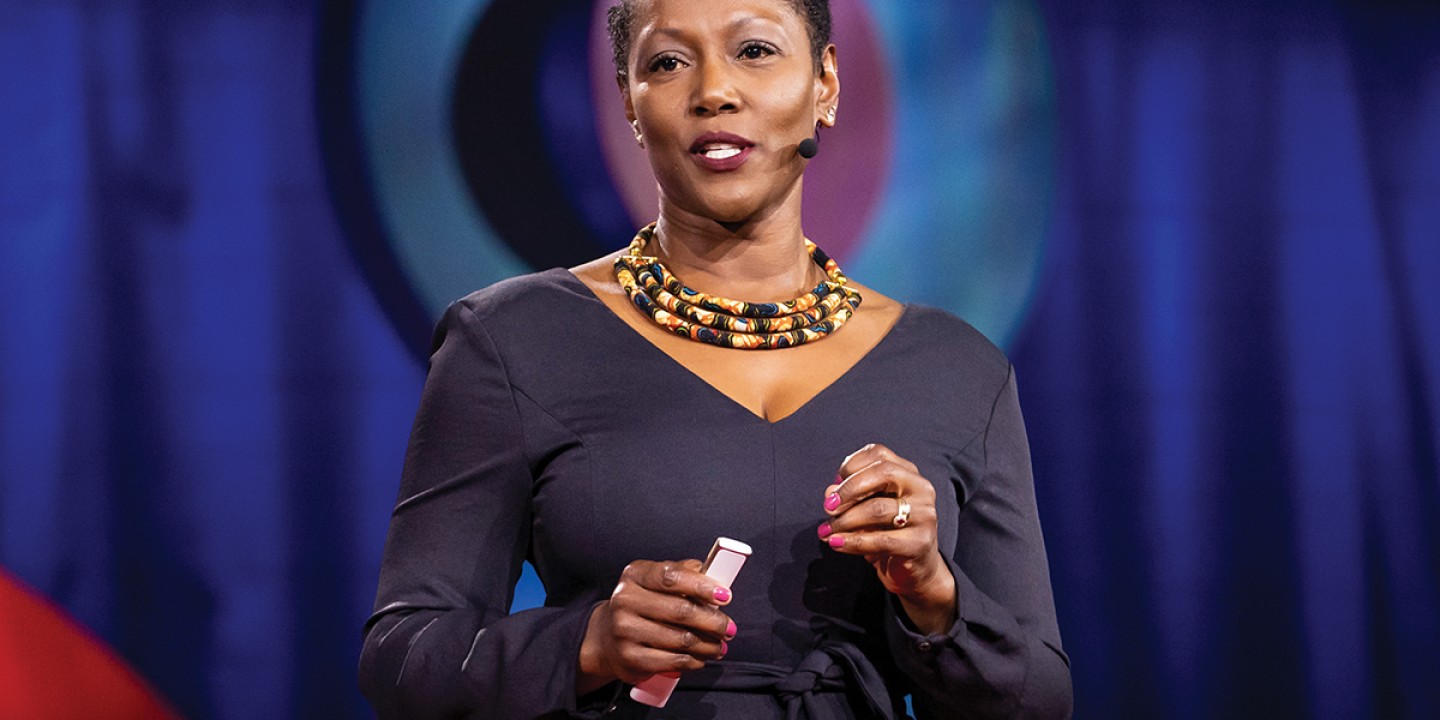Monique W. Morris’s advocacy for Black girls and educational equity
The world sees Black girls as dangerous. Morris shows them that they are scholars.

“When I was in the sixth grade I got into a fight at school,” begins the TED talk that Monique Morris delivered in November 2018. On its face, this statement isn’t extraordinary; lots of children get into fights during their preteen years. But Morris is Black, so the stakes of her fight were high. Black girls are seven times more likely than White girls to be suspended from school. They’re three times more likely to receive corporal punishment in school and four times more likely to be arrested while at school. Being suspended or expelled, physically restrained or beaten by school officers, or arrested while at school can lead to chronic absenteeism, dropping out, and long-term enmeshment with juvenile and criminal punishment systems.
Morris wasn’t suspended, arrested, or physically punished for fighting in sixth grade. “The educators working with me led with empathy. They knew me.” Instead of rushing to judgment, the principal asked her what was going on. She helped Morris process the fight and connect it to her history of trauma, think through better options, and work toward a restorative solution. That little girl whose principal showed empathy is now a professor, educational consultant, juvenile justice advocate, nonprofit organization executive, and best-selling author whose life’s work is aimed at making schools safe and hospitable for Black girls.
It’s an uphill battle, because so much damage has been done to Black girls by educators who fail to keep them safe or attend to their other learning needs. “Schools need to become locations for healing before they can become locations for learning,” Morris says in the 2019 documentary film Pushout, which is based in part on her 2016 book Pushout: The Criminalization of Black Girls in Schools (New Press). The book starts with a summary of how the pushout phenomenon operates:
Too many Black girls are being criminalized (and physically and mentally harmed) by beliefs, policies, and actions that degrade and marginalize both their learning and their humanity, leading to conditions that push them out of schools and render them vulnerable to even more harm.
Morris unveils this narrative in a way that’s both revelatory and indisputable. If there’s one book every K-12 educator in America should read, it’s Pushout.
Why are Black girls being pushed out of school? While Morris identifies multiple causes, one of the most deeply ingrained involves a simple error in perception. Beginning around age four, Black girls are seen by Americans as older than they are. This phenomenon, which social scientists call age compression, is more pronounced with Black girls than with any other demographic.
When adults perceive Black girls as older than their White or male peers of the same age, we’re more likely to sexualize them, to perceive them as caregivers, and to expect them to be in greater control of their emotions. When they fail to meet our high expectations—that is, when they act their age—we regard them as uncooperative or even dangerous. One of the leading reasons given for the over-disciplining of Black girls by school officials is insubordination, a term that reveals a concern with maintaining hierarchy, status, and control. It’s hard for a girl who knows her teacher fears or resents her to believe she can speak up in class without being judged or censored.
These biases are part of the legacy of slavery, and they run deep below the surface. To use Reggie Williams’s metaphor, they’re like a script we’re given at birth. Morris puts it this way:
In a society so shaped by race and gender, we all live with implicit biases that inform our ideas, stereotypes, and norms of Black femininity. . . . This is important because, well, educators are people. It’s unreasonable to think that they are not impacted by the barrage of negative images associated with Black female identity in the popular consciousness.
In other words, no matter how many good intentions a teacher has, she also likely carries some harmful stereotypes that influence her treatment of Black girls. This is true not only of every educator but of every American.
But the pushout phenomenon isn’t only a result of individual people’s biases and actions. The Ending PUSHOUT Act, an educational equity bill introduced in the House of Representatives by Ayanna Pressley (D., Mass.) in 2019 and reintroduced this year, turns pushout into an acronym—Punitive, Unfair, School-based Harm that is Overt and Unresponsive to Trauma—that points to the larger narrative behind educational inequity. Just replace “school-based” with “social” and you’ll get a description of pretty much the entire history of White Americans’ behavior toward everyone else.
If that last sentence seems like an exaggeration, I recommend picking up a copy of Morris’s 2014 book, Black Stats: African Americans by the Numbers in the Twenty-First Century (New Press), which she describes as “a starting point for unraveling the twenty-first-century color line with all its gerrymandered borders around gender, sexuality, and immigrant status.” Black Stats is mostly a litany of statistics—thousands of them—about the lives of Black Americans, gleaned from research papers, scientific studies, corporate surveys, and government data. Every page shows evidence of racial disparities, from liver cancer rates to hiring in STEM fields to death by military combat. Such specific quantitative data is already outdated by the time it gets into print, but the picture that the book paints is timeless. I’ve seen no better compendium of evidence for the persistence of systemic racism.
The systemic racism that Black Stats lays bare is the foundation of educational inequity. The inherited trauma, violence, and poverty that many Black girls are born into can make it difficult or even impossible for them to get to school consistently, project the upbeat attitude their teachers expect, and stay focused on learning. It’s hard for a child who comes to school hungry to perform well on a test. It’s hard for a girl with a history of sexual assault not to lose her temper when a boy who’s been taunting her deliberately steps on her shoe and refuses to apologize (which is what happened to Morris in sixth grade).
Majority-Black schools in impoverished neighborhoods aren’t the only schools where Black girls are pushed out, though they are where Morris conducts much of her research. It happens everywhere adults are charged with teaching Black girls—and it is one of the reasons many of America’s schools and districts have few if any Black girls in them. It’s a problem that harms all children by giving the impression that some students are worth more love and care than others. Being consistently taught that you’re superior to the girl sitting next to you creates a particular type of citizen and community member. It’s moral formation at its worst.
One of the best things about Pushout is that it moves beyond simply diagnosing our social ailment. In a March 2016 interview with the Atlantic, Morris said, “I believe in the healing power of the narrative. Our stories can help us—in this case, as a nation—develop empathic responses to complex social issues.” To this end, Pushout is filled with stories, often in the voices of the Black girls Morris interviews. It’s also filled with best practices, resources for developing nonpunitive accountability, and answers to commonly asked questions. Morris consistently models a strength-based pedagogy by using the term scholar to describe her interviewees and leaning into the joy and resilience she sees in them.
Morris’s 2019 book, Sing a Rhythm, Dance a Blues: Education for the Liberation of Black and Brown Girls (New Press), also uses a narrative approach to paint a picture of “the world that schools, in partnership with gender-responsive, culture-specific programs, are building to interrupt school-to-confinement pathways” for Black, Brown, and Indigenous girls. From a double-Dutch jump-roping contest in Boston’s Roxbury neighborhood to an art therapy group for high-risk students in Portland, Oregon, Morris profiles diverse spaces where adults are working together to overturn the systems and structures that push Black girls out of school.
“Imagine a future for Black girls that is filled with dignity and where their learning spaces are places they are invited to critically engage, alongside educators, in the construction of their education and in the redemption of their lives.” This call to action, which comes near the end of Pushout, begins to take concrete shape in Sing a Rhythm, Dance a Blues.
The Pushout documentary, which draws on both books, ends with a litany of adults interviewed in the film speaking directly to the camera with a simple message: Black girls, you are sacred and loved. And here Morris’s overarching strategy emerges. Like any good sermon, Morris’s work is grounded in a healthy balance of law and gospel, driven by the conviction that people can reinvent themselves through the lens of grace, and aimed at creating a world where power manifests as love.
A version of this article appears in the print edition under the title “Black girl scholars.”





